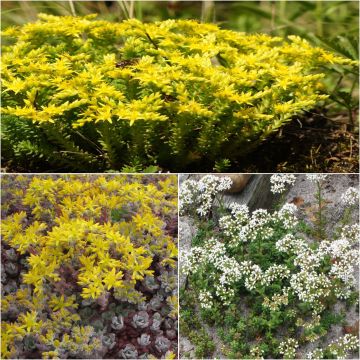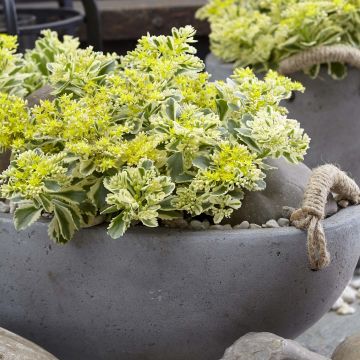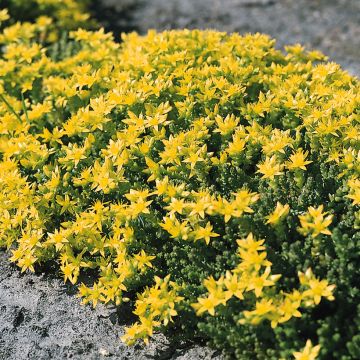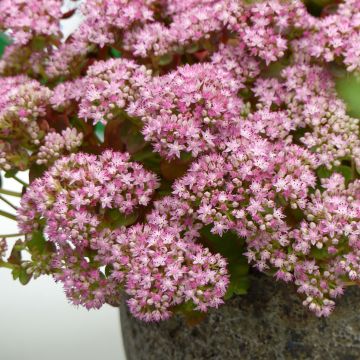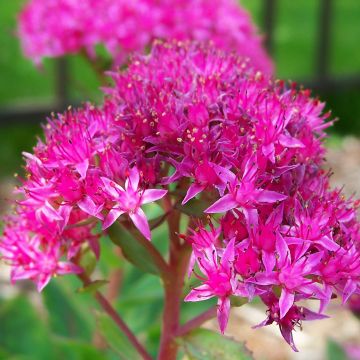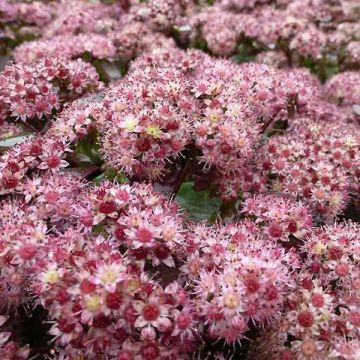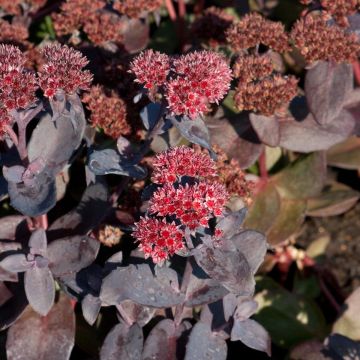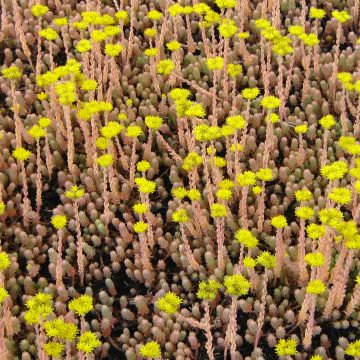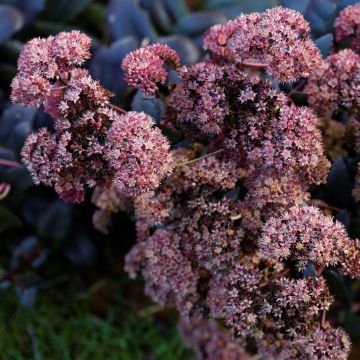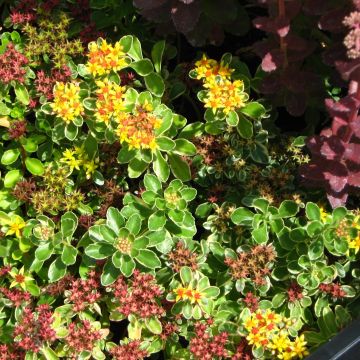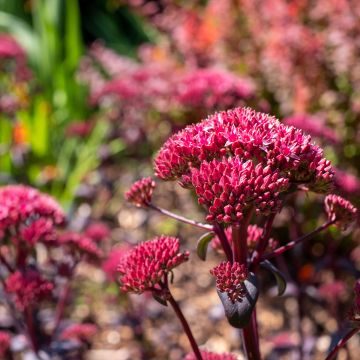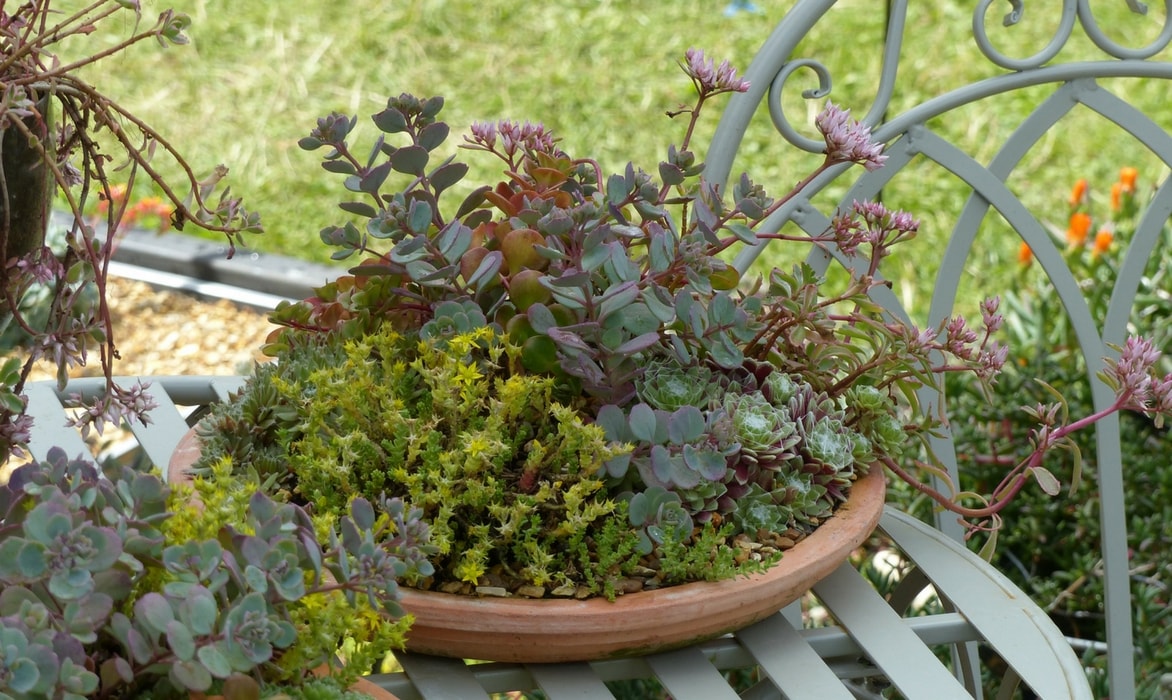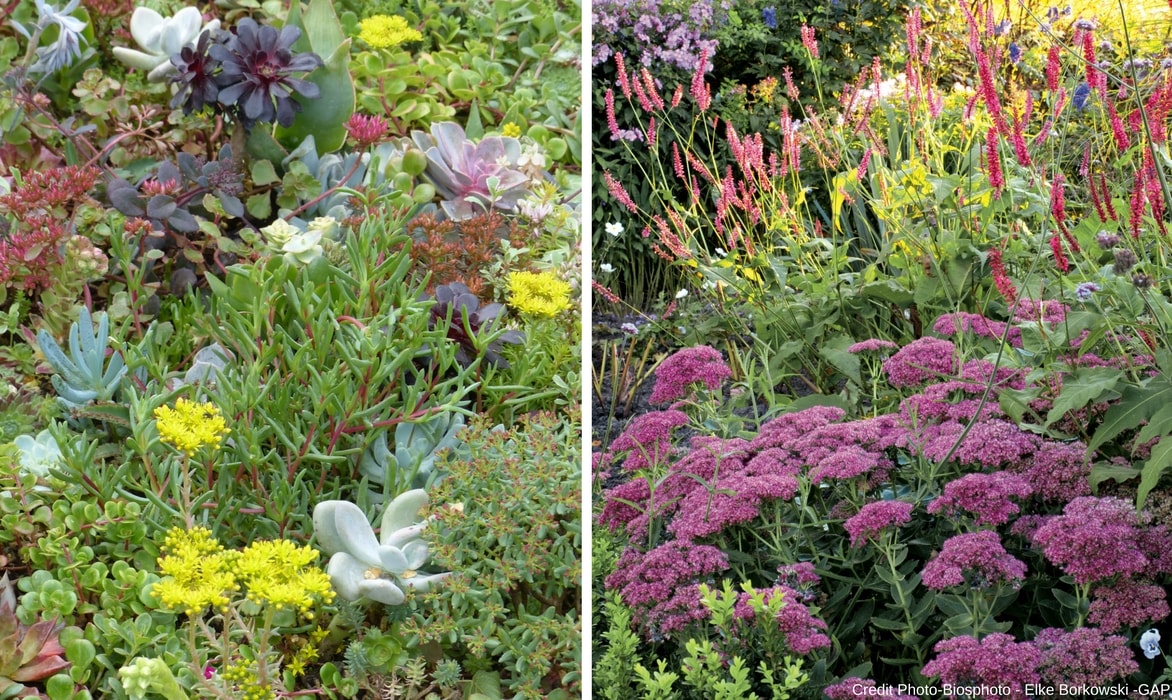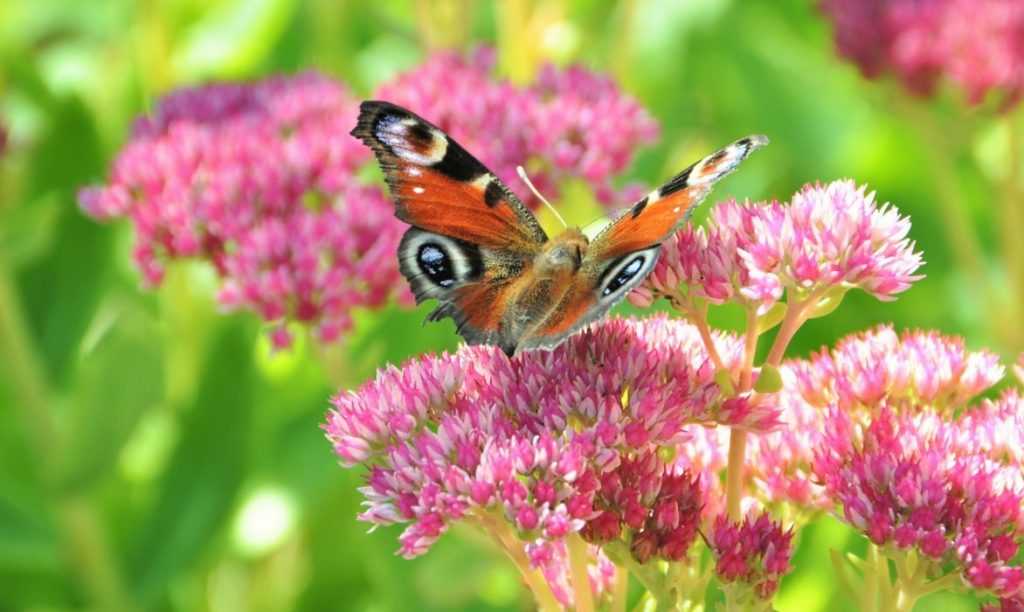
Sedum or Stonecrop: How to Plant, Grow and Propagate Them
Contents
Sedums in a Nutshell
- Sedum is perfect for creating a low-maintenance dry garden! It thrives without fertiliser or watering, even in very poor soil.
- Its late flowering brings colour in early autumn, when the garden begins to lack flowers.
- Sedum flowers offer a great diversity of colours. Discover the stunning pink blooms of Sedum spectabile, yellow of Sedum reflexum or white of Sedum album!
- Grow upright varieties like Sedum telephium in beds or borders, and creeping varieties (Sedum spurium, Sedum reflexum…) as ground cover.
- Extremely hardy, Sedum offers exceptional resistance to drought and temperature fluctuations!
Our Expert's Word
Sedum is an exceptional plant due to its drought resistance, tolerance to temperature fluctuations, and immunity to diseases and pests. It could be described as a highly self-sufficient plant. It thrives independently and does perfectly well even if neglected by the gardener! Cuttings are extremely easy to propagate. It has become the go-to plant for green roofs.
Very much in vogue, Sedum is now a top choice for urban gardens, green roofs, or water-wise landscapes. It aligns with current ecological concerns and urban gardening trends. Easy to grow, it fills empty spaces left by other plants in challenging areas with shallow soils, bringing greenery and colour to these spots even in mid-winter (for evergreen varieties).
This succulent offers great diversity in both form and colour! Its growth habit can be upright or spreading, its flowers come in pink, white, or yellow, and depending on the variety, its foliage ranges from blue-grey to yellow-orange or deep purple. You can mix different species to create a strikingly colourful and varied display! The leaves often turn red or bronze in autumn, making them highly decorative even after flowering has ended.
Sedum works equally well in flower beds (such as Sedum ‘Matrona’) or borders, as well as in rock gardens or green roofs. It can even add a splash of colour to an old stone wall!
Botany
Botanical data
- Latin name Sedum sp.
- Family Crassulaceae
- Common name Stonecrop
- Flowering August to September-October
- Height 15 cm (ground-covering species) and 50 - 60 cm (upright species)
- Exposure Full sun
- Soil type Well-drained, poor
- Hardiness -15 °C
Stonecrops have a wide distribution across the Northern Hemisphere. Numerous species can be found on the American continent, such as the beautiful Sedum palmeri from Mexico, or Sedum lanceolatum, found in Canada and the United States. Stonecrops are also present in Asia, in Eastern China with Sedum spectabile, and around the Mediterranean with Sedum album, extending to the Balkans and Carpathians. They are also found in North Africa.
Sedum belongs to the Crassulaceae family, which includes around 1,500 species of mostly succulent plants. This family includes Kalanchoes, Crassulas, and houseleeks. These succulents, commonly called “fat plants“, have adapted to arid environments by storing water in their tissues, giving them a “plump” appearance. Their metabolism makes them particularly drought-resistant. Their stomata (organs regulating gas exchange) open at night when temperatures are cooler and close during the day to prevent water loss.
There are over 400 species of Sedums, and numerous varieties. They are closely related to the Hylotelephium genus, sometimes used synonymously with Sedum. In France, around thirty species can be found, including Sedum acre, Sedum rupestre, and Sedum album, which typically grow on walls, rocky areas, or dry grasslands in sunny locations.
Sedums can be divided into two main categories:
- Low-growing, creeping Sedums with a mat-forming habit. They hug the ground and typically reach 10 to 15 cm in height. During flowering, they create beautiful carpets of small star-shaped flowers in yellow, pink, or white. Examples include Sedum acre and Sedum spurium. Most of these Sedums are used for green roofs. Their leaves are often small, elongated, and evergreen, displaying various colours (purple, yellow, red, green…), making them highly decorative.
- Tall, upright Sedums, such as Sedum spectabile, which can reach 60 cm in height under good growing conditions. These are mainly used in borders and flower beds. They bear broad, flat, toothed leaves.

Sedum spectabile, – Sedum spurium album: two very different growth habits
Flowering usually occurs late in the season, starting in August. It is so abundant that creeping Sedums sometimes disappear under a carpet of brightly coloured flowers! On upright Sedums, the flowers form dense, flat inflorescences. Even after flowering, the dried flower heads remain decorative due to their shape.
The flowers are small and star-shaped, typically with five petals, five sepals, and ten stamens. They can be white, pink, or yellow. The pink shades vary, ranging from pale to almost red (Sedum ‘Dragon’s blood’). The flowers, particularly those of Sedum spectabile, are nectar-rich, attracting butterflies and bees.

Sedums ‘Sunkissed’ – ‘Carl’ – ‘Sunsparkler Lime-Zinger’

Sedum ‘Eline’ – Sexangulare – ‘Touchdown’
Leaves of Sedums also vary in shape but are always fleshy and relatively thick. As succulents, they store water to withstand drought. Their shape varies: they can be broad and flat (e.g., Sedum spectabile), small and overlapping (e.g., Sedum acre), or cylindrical and elongated (e.g., Sedum album). Leaves of Sedum spectabile can reach 10 cm in length, while those of Sedum acre are only 3 mm!
Most creeping Sedums have evergreen or semi-evergreen foliage, retaining leaves in mild winters. Upright varieties like Sedum spectabile are usually deciduous.
There is remarkable diversity in foliage colours! Some varieties have silvery (Sedum spathulifolium ‘Cape Blanco’), burgundy (Sedum ussuriense ‘Turkish Delight’), or even tricolour leaves (Sedum spurium ‘Tricolor’). Leaves often change colour with conditions, turning red due to drought stress or in autumn. This makes them ideal for creating colourful, patchwork-like displays.


Foliage: Sedum album Coral Carpet – Sedum Red Cauli – Sedum reflexum Angelina – Sedum spathufolium purpureum – Sedum tetractinum Ogon
Roots of Sedums are shallow, making them ideal for green roofs. They thrive with minimal substrate, which is why they grow naturally on walls, rocks, and cliffs. They are undemanding!
Sedums are exceptionally hardy, tolerating both extreme cold and heat. Many species withstand temperatures as low as -15 to -20 °C. They require full sun and excellent drainage, as they cannot tolerate waterlogged soil, which causes root rot. They are wind-resistant and tolerate coastal conditions.
Sedums have medicinal properties, particularly Sedum spectabile. For insect bites, apply the juice from a crushed leaf to soothe the skin. The sap promotes wound healing and relieves burns, inflammation, warts, and haemorrhoids.
Ground-covering Sedums like Sedum acre can almost replace lawns in dry, shallow soils with full sun exposure. This explains their widespread use in green roofing.
Read also
How to create a green roof?Species and Varieties
There are over 400 species of Sedum, and horticulturists have created countless varieties. Twenty-eight of them have been awarded the Award of Garden Merit by the Royal Horticultural Society (RHS).
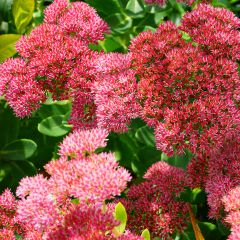
Sedum Herbstfreude - Autumn Stonecrop
- Flowering time September to December
- Height at maturity 50 cm
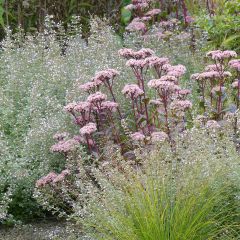
Sedum Matrona - Autumn Stonecrop
- Flowering time September to November
- Height at maturity 60 cm

Sedum reflexum Angelina - Stonecrop
- Flowering time July to September
- Height at maturity 15 cm
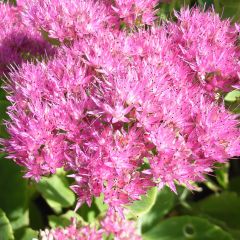
Sedum spectabile Carmen - Autumn Stonecrop
- Flowering time September to November
- Height at maturity 50 cm
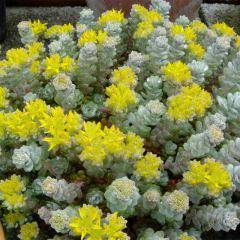
Sedum spathulifolium Cape Blanco - Stonecrop
- Flowering time June, July
- Height at maturity 5 cm

Sedum spathulifolium Purpureum - Stonecrop
- Flowering time September, October
- Height at maturity 10 cm
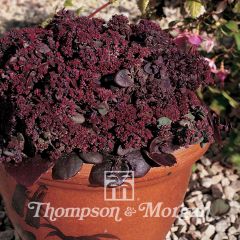
Sedum ussuriense Turkish Delight - Stonecrop
- Flowering time September, October
- Height at maturity 15 cm
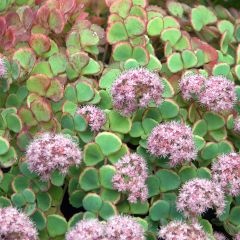
Sedum sieboldii - Stonecrop
- Flowering time October, November
- Height at maturity 15 cm
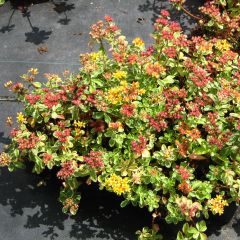
Sedum kamtschaticum Variegatum - Stonecrop
- Flowering time July to October
- Height at maturity 10 cm
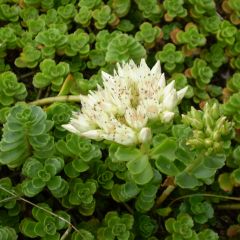
Sedum spurium Album Superbum - Autumn Stonecrop
- Flowering time July, August
- Height at maturity 10 cm
- Sedum acre
Commonly known as “Wall Pepper“, this small Sedum offers a lovely, bright yellow bloom. An excellent ground cover, it spreads easily to form a carpet of yellow flowers. It is one of the smallest Sedums! It has tiny, overlapping leaves, sometimes tinged with red. Hardy down to –15°C, it can be found growing wild in France on walls and roofs in sunny spots. It works wonderfully on green roofs, dry stone walls, or in containers.
- Sedum spurium
Native to the Caucasus, this species grows quite slowly but spreads easily to form a carpet of green leaves. It remains fairly low-growing and produces pretty star-shaped pink flowers in summer, sometimes with reddish hues. The leaves are evergreen, green with reddish tones, flattened, and arranged in two rows along the stem. Very hardy, it tolerates lightly shaded spots. Use it as ground cover or on green roofs.
- Sedum spectabile
Sedum spectabile, or Autumn Stonecrop, is one of the upright species, making it much taller than creeping Sedums. It is especially striking in autumn! From late summer, it bears large terminal inflorescences of star-shaped pink flowers. Some varieties, like ‘Stardust’ or ‘Iceberg’, have white blooms. These nectar-rich flowers are highly attractive to butterflies. Its upright stems carry broad, grey-green deciduous leaves. Native to China and Korea, it is sometimes sold under the name Hylotelephium spectabile.
- Sedum album
Sedum album is a small, slow-growing plant with a creeping habit. In midsummer, it produces charming clusters of white star-shaped flowers. Its small, cylindrical leaves sometimes turn red, especially during dry spells. In France, it grows in wall crevices, on rooftops, or rocky outcrops. Its compact size and spreading habit make it ideal for green roofs.
- Sedum reflexum
Rock Stonecrop is a small, ground-hugging Sedum, often sold as Sedum rupestre. It grows quickly, forming a carpet of green leaves that turn orange-red in autumn. Its evergreen foliage resembles tiny spruce branches. In summer, it bears delicate bright yellow flowers. Hardy to –15°C, it is commonly used on green roofs. There are also cristate forms (caused by a growth anomaly that creates flattened shapes), resulting in highly unusual plants! (Sedum reflexum ‘Cristatum’)
Discover other Sedum
Planting
Where to plant?
The planting location depends on the type of Sedum you have chosen. If you are planting a tall variety with an upright habit, place it in a flower bed or along a path border. However, if you have chosen a low-growing, creeping Sedum, you can position it in a rock garden, on a dry-stone wall, between paving stones or on a green roof. You can also opt to plant your Sedums in pots, creating a composition by combining different species. Since Sedums have very shallow roots and often a spreading habit, choose a pot that is sufficiently wide and not too deep. This will prevent your plants from becoming overcrowded.
Sedums require direct sunlight. They will thrive if placed against a south-facing wall. They also need very well-drained, dry and porous soil. If the soil is heavy, add gravel or coarse sand to improve drainage. It can even be slightly alkaline, but should not be too rich. Sedums tolerate wind and sea spray very well.
Discover Sedums in video:
When to plant?
We recommend planting Sedums in spring, from April onwards. However, autumn planting is also possible if your soil is well-drained and the climate is mild.
How to plant?
- Planting in the ground
Start by moistening the root ball. Then, dig a planting hole. Don’t hesitate to place a layer of gravel at the bottom to aid drainage. You can also mix sand into the planting soil. Add some substrate back into the hole and place the root ball. Fill in the hole, taking care not to bury the crown (base of the main stem). In fact, the plant can be slightly raised above ground level to prevent waterlogging in winter. Gently firm the soil around the Sedum with the palm of your hand. Water. We recommend covering the soil with a light layer of gravel, both for aesthetics and to help the Sedum establish.
If it doesn’t rain, continue watering regularly for the first few weeks after planting. This will help the Sedum take root and begin growing. After that, it won’t need watering.
Small, creeping Sedums benefit from being planted in groups (at least five plants together). Feel free to mix varieties—you’ll create a colourful carpet, thanks to the diversity of foliage and blooms.
For taller varieties, such as Sedum spectabile or Sedum ‘Matrona’, space plants 50–60 cm apart. For smaller ones, like Sedum acre, 15–20 cm is sufficient. Planting is simpler for these low-growing, spreading species. You can simply dig a small hole and lightly bury the root ball.
- Planting in pots
Soak the root balls in water and prepare a substrate made of half sand and half potting compost.
Choose a sufficiently wide container. Place a layer of gravel, perlite or clay pebbles at the bottom to ensure drainage and prevent waterlogging. Then add the substrate. Plant, then gently firm the soil around each plant. Water to help the Sedum establish.
→ Learn more about growing Sedums in pots in our advice sheet!
Maintenance
Sedum requires almost no maintenance. Perfectly drought-resistant, it generally doesn’t need watering. However, if planted in pots with little exposure to rain, you can water it very sparingly. Sedum also has low nutritional needs and thrives in poor soils, making fertiliser unnecessary. In fact, watering and fertilising could make it grow taller, less compact, and more fragile.
It is rarely attacked by pests or parasites, except for gastropods (snails and slugs) and caterpillars, which may nibble on the leaves. If you grow your Sedum in pots, their roots may be targeted by vine weevils (Otiorhyncus sulcatus). However, such attacks remain fairly uncommon, and Sedum is quite resilient. The only issue to watch for is root rot if the environment is too damp.
We recommend cutting back the clump in early spring using secateurs, removing dry stems and faded flower spikes.
If you’ve planted your Sedum in pots or containers, you can leave them in place for several years without repotting.
Propagation
Sedum, like most succulent plants, naturally propagates vegetatively from a single leaf or stem touching the ground. Cuttings are therefore very easy. You can also propagate it by sowing or division. If you leave the faded flowers, Sedum will tend to self-seed naturally.
Sowing
Sow sedum seeds preferably in spring. The fine size of the seeds makes the process a bit delicate, less straightforward than with other species.
The seedbed must be very fine, as the seeds are small. Mix them with sand to facilitate sowing and distribute them as evenly as possible. Do not cover them with soil, but you can lightly press them down to ensure good contact with the substrate. Place the pot in a bright location at a temperature between 20 and 25°C. Water gently from time to time. The seeds will germinate within a few weeks.
Division
You can divide your Sedums every 3 to 4 years. This should be done in spring, around March.
For tall, upright varieties, you can cut them back to reduce their height. This will make the operation easier and help the plant cope. Dig widely around the base. Gently lift the plant from the soil, preserving as many roots as possible. Separate the plant, ensuring each division has enough healthy roots. Replant immediately in its new location. Water well.
Cuttings
Taking cuttings from Sedums is very easy, as some species naturally develop roots as soon as a stem touches the ground. This is best done in late spring, before the plant flowers.
Two types of cuttings are possible:
- Leaf cuttings
Prepare a pot by filling it with a mix of compost and sand. Add a thin layer of sand on top to prevent waterlogging. Take a few leaves, detaching them cleanly from the mother plant. We recommend letting them dry in the shade for a few days to reduce the risk of rot. Place the leaves on the substrate—there’s no need to bury them.
- Stem cuttings
Take a 10 cm stem, cutting cleanly just below a node (the point where leaves meet the stem). Remove the lower leaves. Plant the stem in a substrate of compost and sand, pressing it in lightly. Firm the soil gently around the stem. Water and wait. The cutting will develop new leaves and roots within a few weeks.
Once the plant is well established, you can repot it.
→ Learn more with our tutorial: How to propagate Sedums?
Association
Sedums offer such a diversity of shapes and colours that numerous combinations are possible! The key is to choose plants with the same requirements: dry, well-draining soil and sunny exposure. Generally, rock garden or alpine plants work very well: stemless Gentians, Bellflowers, Rockroses or Saxifrages. Houseleeks (Sempervivum) pair beautifully with mat-forming Sedums! If you’re planting your Sedums on a drystone wall, you could combine Sedum album or Sedum spurium with Campanula muralis!
Sedum can also easily integrate into a Mediterranean-style garden, dry and predominantly mineral. It will complement Lavender, Thyme or Cotton Lavender. You might add some elegant ornamental grasses: they’ll bring lightness alongside the more substantial foliage of Sedums.
Useful resources
- Our wide range of Sedums
- How to take cuttings from Sedum spectabile
- Article by Véronique Mure, Botanist and Tropical Agronomy Engineer: Essential Sedums… from medicinal garden to ornamental garden, September 2011
- Olivier’s video: Decorative ideas with succulents
- Video: Sedums
- Our tutorial on creating a green roof
- Our advice sheet: Evergreen and decorative ground-cover perennials
- Subscribe!
- Contents



































